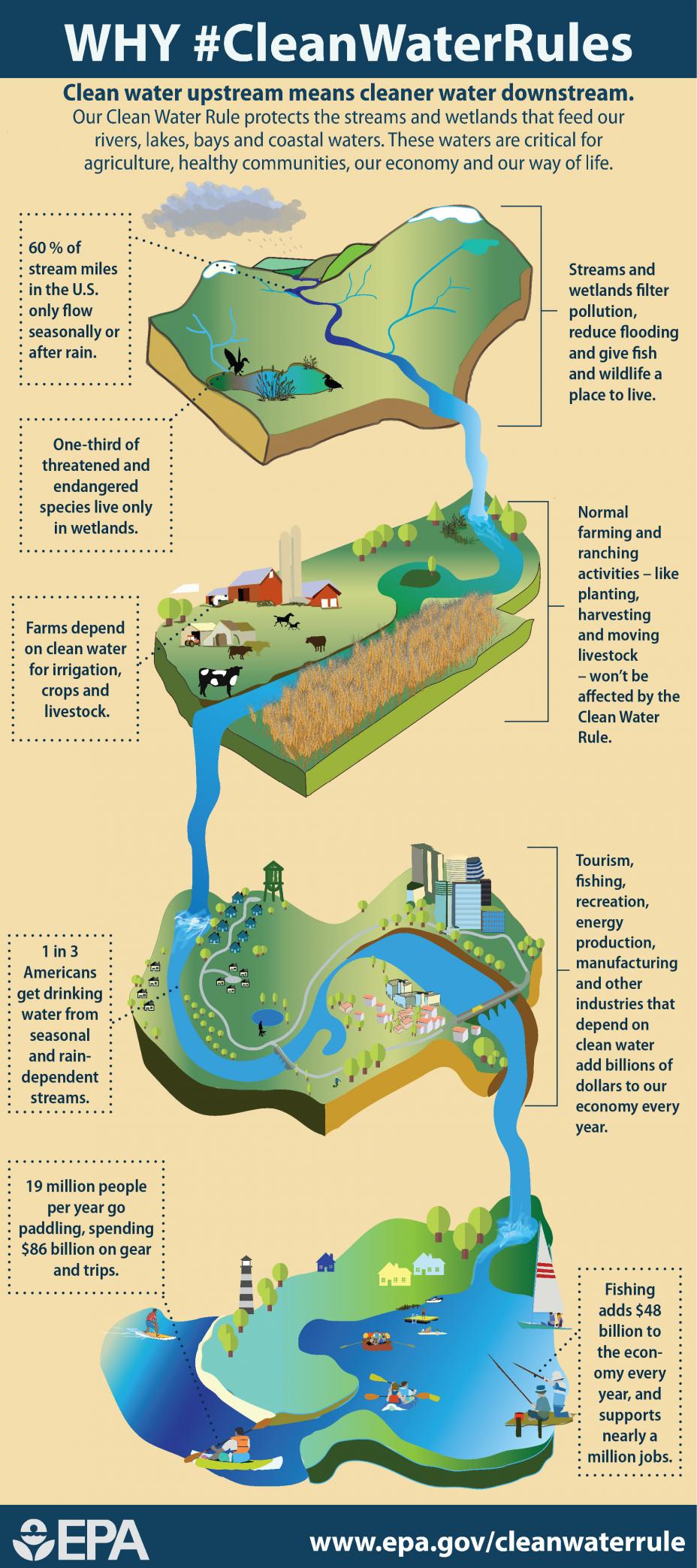aNewDomain — The Trump administration announced today that it’s got a gag order on the Environmental Protection Agency, prohibiting the U.S. agency from communicating with American citizens.
At the same time it suspended all new EPA work assignments, contracts and grants.
Then, in a move it ordered the EPA to keep confidential, it killed the Clean Water Rule. After a leak, Pres. Donald Trump’s press secretary confirmed the move.
 A measure intended to protect the drinking water supply of about 117 million Americans — it protects the upstream tributaries that flow into their water sources — the Clean Water Rule was finalized in 2015 by the EPA and U.S. Army’s Core of Engineers.
A measure intended to protect the drinking water supply of about 117 million Americans — it protects the upstream tributaries that flow into their water sources — the Clean Water Rule was finalized in 2015 by the EPA and U.S. Army’s Core of Engineers.
Specifically, it protects the streams and wetlands that feed into protected lakes, rivers, bays and coastal waters, according to an EPA’s site.
Due to Trump’s gag order, EPA officials could not comment on the matter. The EPA is no longer allowed to communicate with the American citizens it serves, but this much is clear:
One in three Americans just lost a critical protection that keeps their drinking water clean and safe.
In its 2015 press release explaining the Rule, EPA administrator Gina McCarthy emphasized its importance and explained what the Rule did and didn’t do. She said:
“For the water in the rivers and lakes in our communities that flow to our drinking water to be clean, the streams and wetlands that feed them need to be clean,” explained EPA Administrator Gina McCarthy in a 2015 release.
“Protecting our water sources is a critical component of adapting to climate change impacts like drought, sea level rise, stronger storms, and warmer temperatures,” McCarthy added. “The EPA and the Army finalized the Clean Water Rule to protect these important waters, so we can strengthen our economy and provide certainty to American businesses.”
The main thrust of the Rule was to make it easier, cheaper and quicker for businesses and industry to comply with Clean Water Act, cornerstone federal legislation that protects the some 60 percent of US waters that are in danger of pollution and natural damage.
The 2015 rule marked “the beginning of a new era in the history of the Clean Water Act,” Army assistant secretary Jo-Ellen Darcy said at the time.
It was “a response to the public’s demand for greater clarity, consistence and predictability when making jurisdictional determinations,” she added.
Note: As we expect Trump to force the EPA to remove all data and statistics around the Clean Water Rule from its site, we are backing up EPA.gov in full. We now are adding all material from its EPA.gov/CleanWaterRule page to this post … -Ed.
The EPA is the third government agency to be gagged by Trump since he officially took office last Friday.
Along with the USDA and the Interior departments, the EPA may no longer communicate via public channels, and may”only send out critical messages, as messages can be shared broadly and end up in the press,” according to the White House directive.
The EPA.gov site, which typically posts a half dozen news items and blog posts daily, not to mention a stream of information on Twitter, Facebook and Instagram, has been silent since Friday, Jan. 20, the same day Trump took office.
It’s worth noting Trump yesterday designated Jan. 20 as a holiday heradling his rise to power, called Day of Patriotic Devotion.
The one in three Americans who now have no way to ensure their drinking water is clean and safe likely won’t be celebrating.
What does did the Clean Water Rule do?
The point of the Clean Water Rule, which the EPA and the U.S. Army Corps of Engineers finalized in 2015, was to “clearly protect the streams and wetlands that form the foundation of the nation’s water resources,” EPA.gov site explains.
“Protection for many of the nation’s streams and wetlands has been confusing, complex, and time-consuming as the result of Supreme Court decisions in 2001 and 2006,” the EPA wrote.
“Those rulings had limited the ability of the (federal) Clean Water Act to protect the American waterways and water supply because the rulings could be interpreted as allowing companies to pollute the tributaries and streams that flow downstream into them,” the site says.
“The Clean Water Rule ensures ensured that waters protected under the Clean Water Act are more precisely defined, more predictably determined and easier for businesses and industry to understand,” the EPA said.
The Clean Water Act, federal law that is distinct from the Rule, only protects 60 percent of America’s rivers, lakes and canals because those are waters it has designated as in danger of pollution … CONTINUED BELOW ….
Below, find the Federal Register notice that describes the EPA/DOD Clean Water Rule in detail.
Federal Register: EPA-Army Clean Water Rule by Gina Smith on Scribd
Here is the 2015 press release the EPA and Army issued, which announced the Clean Water Rule …
Washington – In an historic step for the protection of clean water, the U.S. Environmental Protection Agency and the U.S. Army finalized the Clean Water Rule today to clearly protect from pollution and degradation the streams and wetlands that form the foundation of the nation’s water resources.
The rule ensures that waters protected under the Clean Water Act are more precisely defined and predictably determined, making permitting less costly, easier, and faster for businesses and industry. The rule is grounded in law and the latest science, and is shaped by public input. The rule does not create any new permitting requirements for agriculture and maintains all previous exemptions and exclusions.
“For the water in the rivers and lakes in our communities that flow to our drinking water to be clean, the streams and wetlands that feed them need to be clean too,” said EPA Administrator Gina McCarthy. “Protecting our water sources is a critical component of adapting to climate change impacts like drought, sea level rise, stronger storms, and warmer temperatures – which is why EPA and the Army have finalized the Clean Water Rule to protect these important waters, so we can strengthen our economy and provide certainty to American businesses.”
“Today’s rule marks the beginning of a new era in the history of the Clean Water Act,” said Assistant Secretary for the Army (Civil Works) Jo-Ellen Darcy. “This is a generational rule and completes another chapter in history of the Clean Water Act. This rule responds to the public’s demand for greater clarity, consistency, and predictability when making jurisdictional determinations. The result will be better public service nationwide.”
People need clean water for their health: About 117 million Americans – one in three people – get drinking water from streams that lacked clear protection before the Clean Water Rule. America’s cherished way of life depends on clean water, as healthy ecosystems provide wildlife habitat and places to fish, paddle, surf, and swim. Clean and reliable water is an economic driver, including for manufacturing, farming, tourism, recreation, and energy production. The health of our rivers, lakes, bays, and coastal waters are impacted by the streams and wetlands where they begin.
Updating …
For aNewDomain, I’m Gina Smith.
Cover image: CitizenGo.org, All Rights Reserved;













